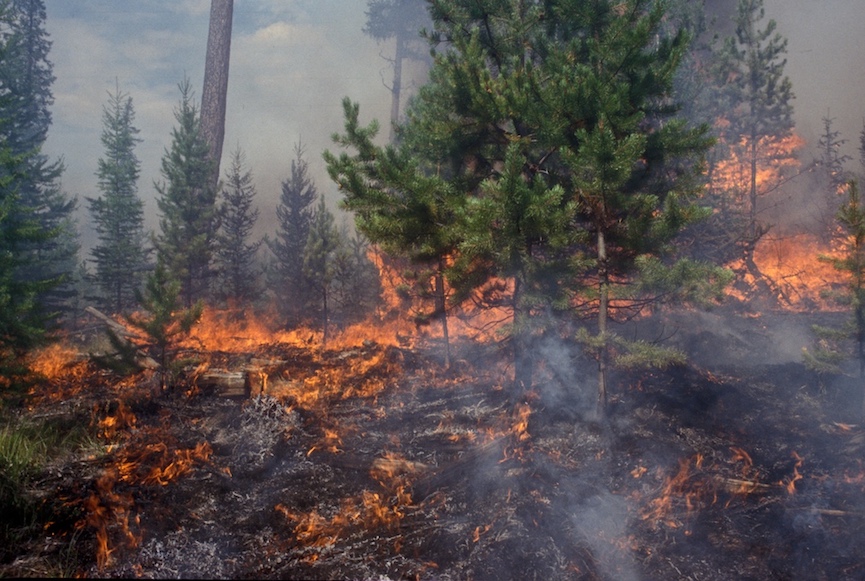Scientists, journalists, environmentalists and others who draw the connection between increasing wildfires and global warming often face a backlash. It’s not climate change; it’s lightning, careless smokers or campers, poor forestry management, industrial activity or sparks from vehicles, bad government…
One doesn’t negate the other. Wildfires have many causes, and more than one factor is fuelling increases in the number and intensity of fires worldwide. But hotter, drier weather increases the risk.
Forestry practices and urban development are among the contributors to wildfires. Even preventing fires can increase risk, as low-intensity natural fires clear out undergrowth, often leaving larger trees standing. Suppressing wildfires means more undergrowth, dead trees and other vegetation build up, creating fuel for even larger fires. Smaller trees can spread flames to the forest canopy.
After clear-cut logging or fires, companies often plant single species close together, eliminating trees like aspen and birch, which are less fire-prone and create shade and moisture. Some commonly planted species, such as lodgepole pine, are also susceptible to pine beetle attacks.
University of British Columbia scientist Lori Daniels told Vancouver Is Awesome that “a forest full of mixed species and mixed densities of those species” is more resistant to intense fires and provides more nutrients and less fuel to the ecosystem.
But some researchers argue that because fire suppression resources and technologies and logging practices haven’t changed much over the decades, while wildfires have rapidly increased in number and intensity, climate change is likely the primary factor.
Even the mountain pine beetle outbreaks that have devastated B.C. forests are a result of both management practices and climate change. Cold winters once killed off many of them, but warmer winters and earlier spring weather allowed them to survive and thrive.
Forestry must be re-evaluated in light of the increasing awareness not only of its role in wildfires but of the way forests function. Peter Wohlleben’s The Hidden Life of Trees and the book I wrote with Wayne Grady, Tree: A Life Story, examine emerging science regarding the complexity and interconnectedness of healthy forest ecosystems. Forests are far more than stands of timber, uniformly planted to maximize profits.
It’s important to improve the way we manage and utilize forest resources, but we also have to consider the major role climate change plays in wildfires. As the world warms, precipitation patterns change, winters are drier in many areas, snowmelt occurs earlier and forests dry out. The fire season is growing rapidly in many parts of the world, including the U.S. and Canada — by as much as 80 days over three decades in the Rocky Mountains — and significantly more area burns every year.
Regardless of the direct causes, climate change is making things worse. A recent Portland State University study found a warmer world even increases the risk of lightning-ignited fires. “We think that by having warmer oceans and warmer temperatures in general, we’re going to see higher evaporation and heat transfer, and thus higher frequency of convective storms that in turn results in more lightning-ignited fires,” said study co-author Andrés Holz.
With drier conditions, longer burning seasons and more fuel on the forest floor, lightning, a discarded cigarette or runaway campfire is more likely to cause an out-of-control wildfire.
The consequences are devastating. Death and compromised health from smoke and particulate matter; home and property damage, especially as urban areas encroach further into wildlands; erosion and flooding as trees no longer hold soils and hillsides in place; contaminated drinking water; increasing insect infestations; destruction of important carbon sinks like the boreal forest… And as forests burn, they emit greenhouse gases, heating the world even more.
All of this is incredibly expensive. Canada and the U.S. spend billions every year to fight fires, and those costs are rising. Destroyed or damaged property, resource losses and health-care costs related to fires are increasing as well. Loss of wildlife and habitat is also a serious concern.
We can do a lot to prevent fires: avoid campfires and other burning when risks are high, improve forestry practices, better manage buffers between urban and forested areas, maybe even let some smaller fires burn.
But until we address climate change, we’re likely to see more smoke-clogged skies and devastated forests.
Written with contributions from David Suzuki Foundation Senior Editor Ian Hanington.
Learn more at www.davidsuzuki.org.
Image: August Gregg/Flickr
Like this article? rabble is reader-supported journalism.





